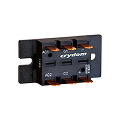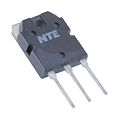Discrete semiconductor components are essential building blocks in modern electronics, forming the backbone of circuits used in nearly every industry. These components, such as diodes, transistors, rectifiers, thyristors, and transient voltage suppressors (TVS), control, convert, and regulate electrical signals in a wide range of applications. Industries like automotive, industrial automation, consumer electronics, and telecommunications rely on these devices for everything from power management to signal processing.
When selecting discrete semiconductor components, start by evaluating the key performance needs of your circuit. Pay close attention to electrical characteristics such as voltage rating, current handling, power dissipation, and switching speed. Each of these parameters directly affects the reliability and efficiency of your application. Consider the intended operating environment as well. Will your design face temperature extremes, vibration, or space constraints? Finally, prioritize supplier authentication and inventory confidence. Buying from an authorized distributor, such as Online Components, reduces risk by guaranteeing genuine parts and ensuring consistent delivery.
Discrete semiconductor components prove indispensable across numerous industries. Power supplies and energy management systems rely on rectifiers and transistors for efficient energy conversion. Automotive systems use TVS diodes and MOSFETs to protect electronics from voltage spikes and manage power distribution, with growing applications in electric vehicles and advanced driver assistance systems.
Telecommunications infrastructure depends on fast-switching diodes and transistors for clean signal transmission and switching, particularly in emerging 5G networks. In consumer electronics, compact and efficient components support a wide range of devices, from smartphones to home appliances. Industrial automation and control systems need robust transistors and thyristors for precise motor control and load management. The Internet of Things (IoT) and smart grid technologies continue driving additional demand for these versatile components.
Online Components stands out through its deep, U.S.-based inventory and fast, reliable shipping. All products are sourced from fully authorized suppliers, guaranteeing authenticity and compliance with all industry standards. Our customers benefit from responsive, knowledgeable support at every stage, whether they're searching for a specific part or tracking an urgent order. The streamlined online platform enables fast and straightforward sourcing of discrete semiconductor components, offering transparent pricing and a smooth checkout process. Looking for the correct part? Purchase from our discrete semiconductor components catalog today.
A discrete component performs a single function, such as switching or rectification, whereas an IC combines multiple electronic functions in a single package. Discrete semiconductors provide more flexibility for custom designs.
Selecting between a MOSFET, BJT, or IGBT depends on your voltage, current, and switching speed requirements. MOSFETs excel in high-speed, low-voltage applications; BJTs are suited for analog amplification; IGBTs are ideal for high-power switching.
Most major manufacturers offer Restriction of Hazardous Substances (RoHS) compliant components; however, it's essential to verify compliance by checking the product datasheet or using Online Components' search filters. RoHS compliance remains current and continues to evolve with the introduction of updated regulations in 2025.
Discrete semiconductors are individual electronic components that perform a single electrical function. The most common types include diodes, transistors (BJT, FET, MOSFET), thyristors, and rectifiers. Unlike integrated circuits, these components aren't packaged with multiple functions or systems. They're essential building blocks for amplification, switching, signal modulation, and power control in circuits. Choosing the right type depends on your application requirements, such as voltage handling, switching speed, and thermal conditions.
BJTs are current-controlled devices that offer good linearity and gain, making them well-suited for analog applications. MOSFETs are voltage-controlled devices with high input impedance and faster switching capabilities, making them ideal for digital and power applications. For low-voltage, high-speed switching, MOSFETs are typically the better choice. However, BJTs may deliver superior performance in linear amplification tasks. Base your decision on switching frequency, load type, and control circuit design requirements.
When selecting a diode, consider three key parameters: forward current rating, reverse voltage rating, and reverse recovery time. The forward current indicates the maximum current the diode can safely conduct, while the reverse voltage represents its ability to withstand back voltage without breaking down.
For high-speed or switching applications, reverse recovery time becomes particularly important. Don't forget to evaluate power dissipation and packaging to ensure thermal and physical compatibility with your design. Schottky diodes, for instance, offer lower forward voltage drop and faster switching compared to standard silicon diodes.
Thermal management is crucial, particularly for power-handling components such as power transistors, rectifiers, and voltage regulators. Exceeding thermal limits can degrade performance, shift parameters, or cause permanent component failure.
Always verify junction temperature ratings and consider using heatsinks, thermal pads, or strategic PCB design techniques to improve heat dissipation. You may also need to derate components based on ambient temperature and operating conditions. Proper thermal design ensures both long-term reliability and safety.
Yes, but you need to ensure the component's input/output characteristics match the logic levels and drive capabilities of your microcontroller or logic circuit. For example, when using a transistor as a switch, it should be able to turn on fully (reach saturation) with the control signal you're providing. Use appropriate base or gate resistors and verify threshold voltages, particularly for MOSFETs, to ensure accurate operation. Some discrete devices may require level shifting or buffering for proper compatibility. Always consult component datasheets to ensure correct interfacing.
See More



